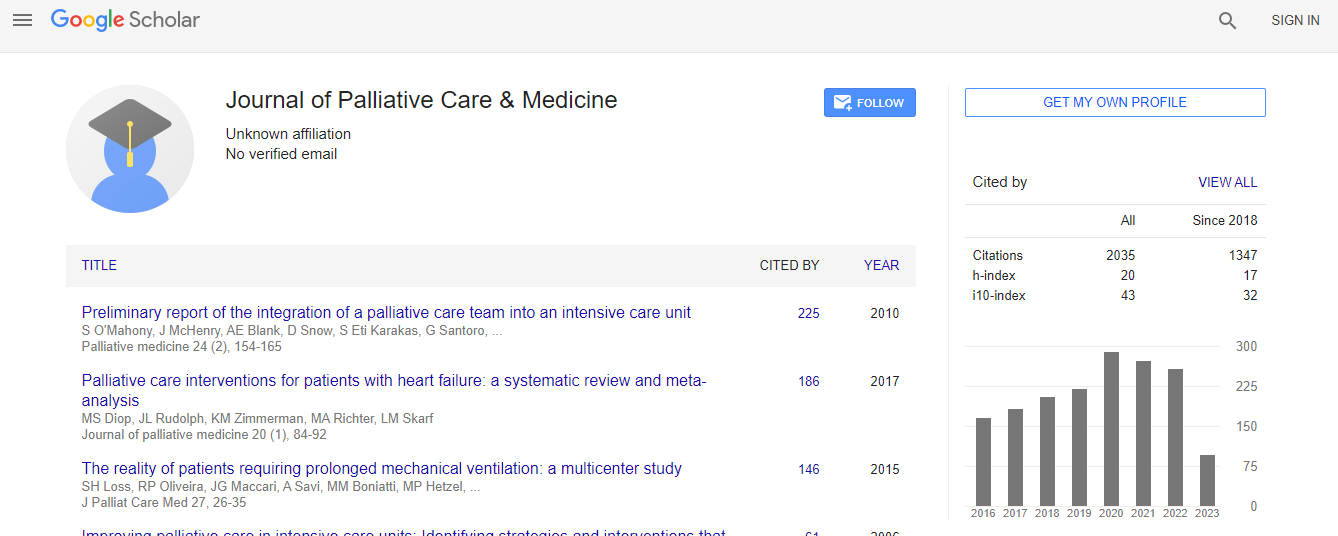Our Group organises 3000+ Global Conferenceseries Events every year across USA, Europe & Asia with support from 1000 more scientific Societies and Publishes 700+ Open Access Journals which contains over 50000 eminent personalities, reputed scientists as editorial board members.
Open Access Journals gaining more Readers and Citations
700 Journals and 15,000,000 Readers Each Journal is getting 25,000+ Readers
Google Scholar citation report
Citations : 1689
Journal of Palliative Care & Medicine received 1689 citations as per Google Scholar report
Journal of Palliative Care & Medicine peer review process verified at publons
Indexed In
- Index Copernicus
- Google Scholar
- Open J Gate
- Genamics JournalSeek
- China National Knowledge Infrastructure (CNKI)
- Electronic Journals Library
- RefSeek
- Hamdard University
- EBSCO A-Z
- OCLC- WorldCat
- Virtual Library of Biology (vifabio)
- Publons
- Geneva Foundation for Medical Education and Research
- Euro Pub
- ICMJE
Useful Links
Recommended Journals
Related Subjects
Share This Page
RISK SCORE TO ESTIMATE SURVIVAL AMONG ADVANCED DEMENTIA IN TAIWAN: A LONGITUDINAL BASED STUDY
2nd Global Congress on Hospice & Palliative Care
Wen-Hsun Hsu, Kwo-Chen Lee and Jia-Jean Yin
China Medical University hospital, Taiwan Veteran General Hospital, Taiwan National Defense Medical Center, Taiwan
Posters & Accepted Abstracts: J Palliat Care Med
Abstract
Background: As the population ages, dementia patients are increasing. Dementia is irreversible chronic degenerative diseases, death is the inevitable result. But the disease course is slow, and the symptom complex in the terminal stage, it cannot effectively predict the time of death. An accurate forecasting tool can help dementia patients to do the advance directives at the end of life, provide the comfort and good quality of life palliative care. Therefore, it will help dementia patients in palliative care, if identify possible predictors of death within six months as the intervention timing reference index. Methods: This study adopted a retrospective cohort study from Taiwan National Health Insurance Database(NHID). Capture diagnosed dementia patient, based on their individual basic characteristics (age, gender), diagnostic classifications (Alzheimer's disease, vascular dementia, other dementia), chronic comorbidities (including stroke , hypertension, diabetes, coronary artery disease, heart failure, renal failure, cancer, high cholesterol, chronic obstructive pulmonary disease and cirrhosis); and six months before the death of acute illness (pneumonia, urinary tract infections, fractures, bedsores , delirium), hospital situation (hospitalization, emergency) and medical treatments (nasogastric tube insertion, oxygen therapy, cardiopulmonary resuscitation, and endotracheal intubation) as index. Statistical methods using statistical software version SAS 9.3. COX proportional hazards model was used to identify risk factors of death in the derivation set. Then, we use the steps proposed by the Framingham Heart Study to build a mortality prediction model with the scoring system in Taiwan within a six-month and one-year survival rate of elderly people with dementia. The performance of the risk models was evaluated by the area under the receiver operating characteristic curve (AUROC). Results: The mortality rate was 55.1% (n = 20542) in 2000-2010. A total of 19 variables as mortality risks, including diagnosis, age, sex, cancer, renal failure, pressure ulcers, sepsis, hospital, nasogastric tube insertion, oxygen therapy, the sum risk score ranged from 0-17 points. AUROC verify this model of risk of death, which is 0.6964in six months, 0.6968 in one year. Conclusions: This model from Taiwan National Health Insurance database which has a moderate prediction accuracy within six-months and one-year of death in elderly dementia.Biography
Kwo-Chen Lee has completed her Ph.D. from the school of nursing of National Yang-Ming University in Taiwan in 2011. Lee had been working in the clinical oncology ward for 12 years before getting to her Ph.D. degree. She also interested in nursing research while in university, and has published more than 10 papers in reputed journals. She is an associate professor of nursing at China Medical University, Taiwan since 2011. Her major studies are palliative care and end of life care among patient and family caregiver. She recently worked on family caregiver support with terminally ill patient studies, and she received the NIH funding from Taiwan’s government in 2015-2017. Lee also has been serving as an editorial board member of repute in Taiwan.
Email: rubylee@mail.cmu.edu.tw

 Spanish
Spanish  Chinese
Chinese  Russian
Russian  German
German  French
French  Japanese
Japanese  Portuguese
Portuguese  Hindi
Hindi 
